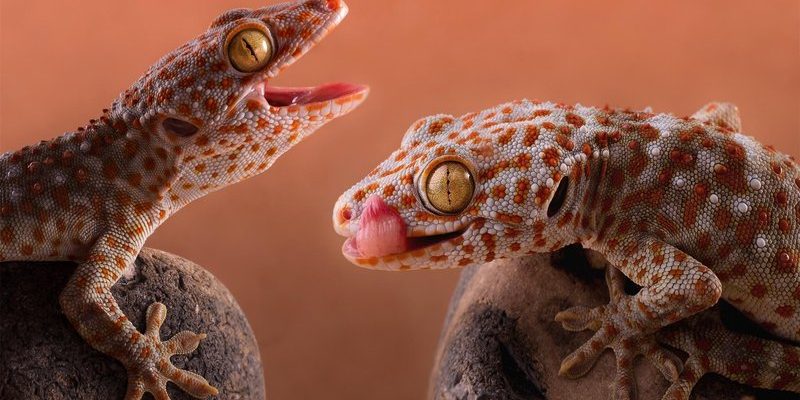![Tokay Gecko Vs. [Similar Species] - How They Compare](https://gudri.com/wp-content/uploads/2025/06/Tokay_Gecko_Vs___Similar_Species____How_They_Compare_image_0.jpg)
To give you a clearer picture, let’s dive into the Tokay Gecko and compare it to another popular lizard species, the Green Anole. Both are remarkable in their own right, but they have their own quirks, habitats, and behaviors. By the time we’re done, you’ll have a good grasp of how these two fascinating reptiles relate and contrast with each other.
Introducing the Tokay Gecko
The Tokay Gecko is a standout in the lizard world. Found mainly in Southeast Asia, these lizards are known for their striking blue and orange coloration. They have a robust build and can grow up to 12 inches long. What’s fascinating about these creatures is their vocalization; Tokay Geckos are notorious for their loud “Tokay!” cries, which they use to communicate, especially during mating season.
This gecko typically favors humid, tropical environments, making its home in forests and near human dwellings. They’re primarily nocturnal, so don’t expect to see them during the day! One of the most interesting things about the Tokay Gecko is its adaptability. While it prefers trees, it can often be found lurking in urban areas, showcasing its versatility.
Meet the Green Anole
Now, let’s shift gears and talk about the Green Anole. These little green lizards are often found in the southeastern United States. They’re much smaller than Tokay Geckos, averaging around 5-8 inches in length. What’s charming about the Green Anole is its color-changing ability; they can shift from bright green to brown, depending on their environment and mood.
Green Anoles thrive in a variety of habitats, including gardens and forests. They’re diurnal, meaning you’ll catch them basking in the sun or hunting insects during the day. Their diet consists mainly of small insects and spiders, making them beneficial for your garden. Plus, they’re a common sight in many backyards, adding a splash of color to your outdoor space.
Physical Differences
When comparing the Tokay Gecko to the Green Anole, their physical differences are quite striking.
- Size: The Tokay Gecko is generally larger, reaching up to 12 inches, while the Green Anole is much smaller, typically measuring around 5-8 inches.
- Coloration: Tokay Geckos are adorned with vivid blue and orange patterns, while Green Anoles can shift colors but primarily show a bright green hue.
- Build: Tokay Geckos are more robust, with a thicker body and a larger head, whereas Green Anoles are slender and agile.
These differences are not just for looks. Each adaptation helps the reptiles thrive in their respective environments. The robust build of the Tokay Gecko enables it to hunt larger prey and withstand harsher conditions, while the Green Anole’s agility allows it to dart quickly amid foliage to evade predators.
Behavioral Traits
Behaviorally, these two lizard species couldn’t be more different. Tokay Geckos are known for being quite territorial and aggressive, especially males. They often engage in loud vocalizations to establish dominance, and their bite can be pretty painful if they feel threatened.
In contrast, Green Anoles tend to be more relaxed and shy. They prefer to bask in the sun and are often seen displaying their dewlap—a flap of skin under their throat—during courtship rituals or when feeling threatened. This non-aggressive behavior makes them ideal pets for beginner reptile enthusiasts.
Habitat Preferences
When it comes to habitat, the Tokay Gecko and Green Anole have distinct preferences that shape their lifestyles.
- Tokay Gecko: They thrive in humid, tropical conditions, often found clinging to trees or buildings. Their ability to adapt means they’re equally comfortable in urban environments, hunting insects under streetlights.
- Green Anole: These lizards prefer sunny areas with plenty of vegetation. You might spot them basking on branches or fences, blending seamlessly into their surroundings.
The difference in habitat also influences their diets. Tokay Geckos consume a wider variety of prey, including larger insects and even small vertebrates. On the other hand, Green Anoles stick primarily to smaller insects, which they catch with their quick reflexes.
Care and Keeping
For those interested in keeping these reptiles as pets, their care requirements vary significantly based on their natural behaviors and habitats.
- Tokay Gecko: They require a large terrarium with climbing structures and high humidity. A heat source is essential, as they thrive in warm environments. However, their aggressive nature means they do best as solitary pets.
- Green Anole: They need a smaller setup with live plants for hiding spots. A temperature gradient is crucial for their health, and they appreciate a bit of humidity, but not as much as Tokay Geckos.
If you’re considering a pet lizard, think about your lifestyle and how much time you can dedicate to their care. Tokay Geckos may require more hands-on management due to their aggressiveness, while Green Anoles are generally easier to handle.
When it comes to comparing the Tokay Gecko and the Green Anole, you can see just how diverse the lizard family is. Both have unique traits, behaviors, and habitat preferences that make them special in their own right. Whether you’re drawn to the striking colors and spirited personality of the Tokay Gecko or the charming nature of the Green Anole, both species offer a glimpse into the incredible world of reptiles.
Next time you encounter one of these lizards, whether in the wild or as a potential pet, you’ll appreciate the differences and similarities that make each one fascinating. Just like people, these lizards have their own stories to tell, adding richness to the tapestry of life on our planet.

